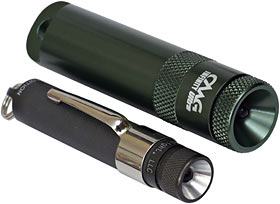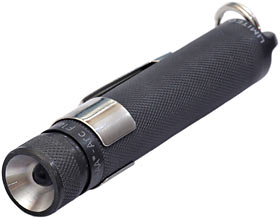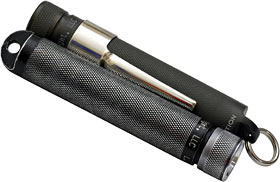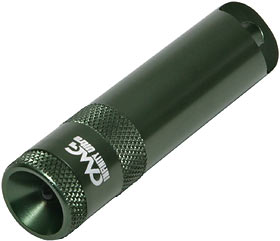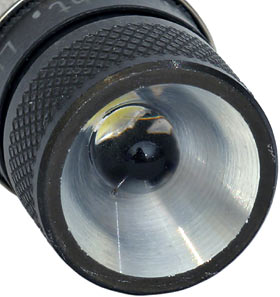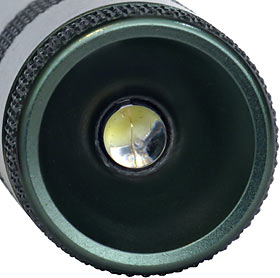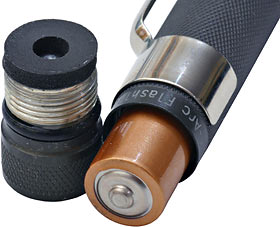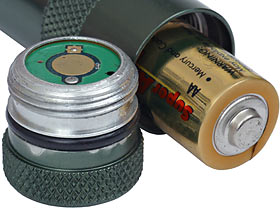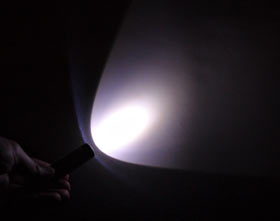
Arc Flashlight Arc-AAA Limited Edition and CMG Infinity Ultra
Date Last modified 03-Dec-2011.
I, you will all be dumbfounded to discover, carry a flashlight with me all the time.
This is not because there are many blackouts where I live, or because I often find myself trapped in cellars, or because I have a morbid fear of the dark. It's not even because people keep sending me the darn things for free.
It is, rather, because a little flashlight is useful surprisingly often, even if you live an life that isn't affected by a more than normal amount of darkness. You don't have to be an adventurer, reviewer, dedicated hobbyist or portable illumination enthusiast. Just carry a light all the time and you'll find that it comes in handy, making your life easier and less dangerous in various small ways.
If you're going to carry a light all the time, though, it'd better be small. It should also have decent battery life, or at least use a common battery type that's easy to change. It should also be bright, and durable.
The bright and durable part, of course, means we're talking LED lighting. High intensity LEDs are far and away the best lamps for very small lights; they have better brightness and efficiency than tiny incandescent filament lamps, and they're functionally immortal.
Key-ring LED lights powered by coin cells, like these ones I reviewed the other day, are so small as to be practically invisible; you could wear a couple as ear-rings. But they don't have very good battery life (fine if you use them only for a few seconds now and then, not so good if you use them for a few minutes every night), they don't use batteries you can buy anywhere, and they don't generally make it terribly easy to change the batteries, either.
The light I carry around all the time, therefore, is a bit bigger. It's an Arc Flashlight Arc-AAA. I reviewed it more than two years ago, here. It's been in my jeans pocket pretty much constantly since. Tough luck if you want to buy one today, though; about a year after I put this review up, Arc Flashlight went broke. My apologies if I've failed to correct any parts of this review that say the company's still in business.
If you want a tiny flashlight with respectable brightness that will last pretty much forever, you want an Arc-AAA. This is partly because it's a really good product, and partly because there's practically no competition in this market niche. The only other company that's made a decent light of this type - one LED, one AAA battery, DC-to-DC voltage converter to feed the LED the voltage it wants and compensate for battery aging - is CMG Equipment.
CMG's single-AAA light is the Sonic. It's about the same size as the Arc-AAA, it's in the same brightness class, it sells for $US20 or less, and it's received complimentary reviews. The worst thing about the Sonic is its peculiarly pointy business end.
But the Sonic's not quite as tough as the little Arc, and not quite as nice looking (if you ask me). And the standard Arc-AAA only costs $US28.95 anyway - it's on special for $US24.95, as I write this.
This is not the standard Arc-AAA. It's the "Limited Edition" version, which is now called the "Premium Edition", and lists (or, you know, listed, seeing as they're bust now) for $US39.95 (it's on special as well, at time of writing, for $US34.95). The Limited Edition Arc-AAA has an absolutely top-class 5mm Nichia white LED; the standard version may have just as good an LED in it, but will probably be a little dimmer, and a little bluer.
If you want to know all about the Arc-AAA, read my old review; the Limited/Premium Edition version is very much the same thing. Now it comes with a pocket clip, and in nice packaging with a Duracell AAA...
...but it's really very much the same thing. The Arc-AAA with the clip is the new one; the other one's the original, that's been bouncing around in my pocket for 27 months, where constant contact with my other two pocket companions has buffed off some of its black hard anodised finish. The current Arc-AAAs have thick anodising too, but it's now natural dark grey in colour, not dyed black.
Here's another update to a previous design. It's CMG's stronger product in the tiny-light market, the Infinity Ultra. The Infinity is fatter than the Arc-AAA, because it uses a AA cell, but it's otherwise basically the same sort of thing.
(It comes with a nice solid lanyard and a pocket clip, by the way; I
left them out of the above picture out of forgetfulness
a deep commitment to a minimalist aesthetic.)
I reviewed the original Infinity here, not long after I reviewed the Arc-AAA. Like everyone else who looked at the Infinity, I was impressed with its solidity and its superb battery life. I was less impressed by the fact that the battery rattles around inside the light; there's no spring to hold it still. The Arc-AAA has a rubber doughnut on the back of the lamp assembly to silence its battery.
I was less impressed again by the Infinity's brightness. It's certainly not uselessly dim, but it's a lot dimmer than other single-LED lamps.
The Infinity Ultra solves this problem by simply driving its LED about as hard as the Arc-AAA does. AA cells have more capacity than AAAs, and are less bothered about the kind of current we're talking here as well, so the Infinity Ultra wins by a large margin in run time. The Arc-AAA is rated for about a five hour battery life before it drops to 50% of its initial brightness. The Infinity Ultra's got a 25 hour "peak brightness" runtime figure.
All LED lights can do a lot more with well-worn batteries than incandescent lights can, mind you. Download this video clip for proof of an Arc-AAA's superiority to the poor old Maglite Solitaire. The Infinity Ultra is just as impressive.
Like the old Arc-AAA, the new one has a silvery reflector behind its LED. Since these LEDs don't throw a lot of light sideways, the reflector is largely cosmetic.
Neither Infinity model has a shiny reflector; there's just a deep conical recess around the LED, which means it's even better protected from harm than the Arc-AAA's.
You unscrew the lamp end of the Arc-AAA to load a battery. It's O-ring sealed; definitely waterproof to 50 feet, and probably a lot further.
If you mangle or lose the foam "battery retainer" that comes stuck to the back of the lamp, by the way, Arc Flashlight will send you a new one for free if you send them a stamped, self-addressed envelope with a note telling them how many retainers you need.
The Infinity Ultra comes apart in the same way. Note the lack of a "retainer", though. When they're turned off, Infinitys rattle and Arc-AAAs don't.
On the plus side, though, you can get lithium AA batteries but not AAAs. A lithium cell will work fine in the Infinity, make it burn a bit brighter (because of a 1.7 volt nominal potential, versus 1.5 volts for regular AAs), and turn it into a mountaineer's friend; lithium cells work much better in sub-zero temperatures than alkalines.
Throwing photons
This is the central portion of the Arc-AAA Limited Edition's beam. No rings, no blotches, no dark middle; all of those problems will pass from our memory with the incandescent bulbs that spawned them.
This is the old Arc-AAA's beam, using the same battery as the Limited Edition. It looks much the same (and much the same colour, too; all of these beamshots use my camera's "flash" white balance setting, which renders them pretty much as they appear to the human eye), but it's actually using a 1/6th second exposure, versus 1/10th for the Limited Edition. I was surprised that it was that much dimmer; at 1/6th...
...the Limited Edition's beam was noticeably overexposed.
I'll get back to the brightness issue in a moment.
Depending on where you draw the line, the Arc-AAA's beam width can be said to be more than 90 degrees; there's easily visible light all the way out to there. This very wide pool of light is what makes most LED flashlights excellent for close-range seeing-where-you're-walking purposes. The really "hot" part of the beam in the middle is more like 25 degrees, though. This is still wider than most fixed-focus incandescent flashlight beams.
Here's the Infinity Ultra's output, at 1/8th second - a bit dimmer than the Limited Edition Arc-AAA, but not enough that you'd notice without side-by-side testing.
Like the Arc-AAA, the Infinity Ultra has a very wide total beam - well over 90 degrees. Its hot spot is much the same as the Arc-AAA's, though.
I was interested to quantify how the new lights compared in brightness with my old Arc-AAA. I aimed them at my light meter from 75 centimetres, and fed the two Arcs the same AAA cell.
The Limited Edition peaked at about 45 lux - blooming respectable for a standard wide angle single LED light.
(45 lux at 0.75 metres is, by the way, equivalent to about 25 lux at one metre, thanks to the tyranny of the inverse square law. For more on what lux and lumens and such mean, check out this old review. This page is also very good.)
My old Arc-AAA, however, could manage only 21 lux at 75cm. Suspecting something was amiss, I cleaned its contacts and used a soldering iron to resurface the positive one, as per the service guide. Now it made it up to 27 lux. The beamshot picture above therefore doesn't quite do it justice.
I think 27 lux peak at 75cm (15 lux at 1m) is pretty good, considering that this Arc is using an LED quite a lot of batches older than the Limited Edition's. Current non-Premium Arc-AAAs are probably significantly brighter.
Firing the Infinity Ultra at the meter gave a respectable 40 lux from 75cm - 22.5 lux at 1m. Much better than the old Infinity.
Overall
If everything goes to caca and the world's ruled by whoever has the coolest V8 Interceptor, the popularity of both of these lights will last as long as battery supplies do (or, uh, as long as the manufacturers do; Arcs aren't likely to get any more popular now that they're not being made any more).
(Later on, shake-lights will be worth their weight in whatever.)
If the Arc-AAA didn't exist (as it now kinda doesn't), I'd be perfectly happy to carry an Infinity Ultra around all day. It's well made, well priced, rock solid and useful. It's probably a bit too fat for some people to tolerate in their pants pocket, but there are plenty of other places you could carry it, and it's not as if it's got sharp corners.
The Infinity Ultra scores a Recommended from me. It deserves a place on the key-rings of all Very Practical People, alongside their P-38.
I'm getting all misty-eyed over the Arc-AAA, though. I review a lot of gadgets, but not many of them really have a place in my heart; this one does. It's still the sterling product it was a couple of years ago, and it'll remain one until AAA batteries go out of fashion. No doubt lamp technology will advance considerably, resulting in lights the same size that deliver better brightness and longer run time, but the Arc-AAA will remain useful. Zippo lighters are hardly new technology, after all.
You do get something extra in the Premium Edition variant of the Arc-AAA, but there's not a thing wrong with the old one, and it was very refreshing to see a product from such a frank and helpful manufacturer.
Oh well. So much for that.
There was an Arc-AA as well, by the way, which was just what you'd expect from the name, and if you were feeling silly there was also an Arc-RGB.
Either model of plain old regular white-LED Arc-AAA, though, comes Highly Recommended from me. If you can find one.
Arc-AAA kindly provided by
Arc Flashlight.
(who went
out of business, but are back now)
Infinity Ultra kindly provided by Spelean (the CMG Equipment site is here).
